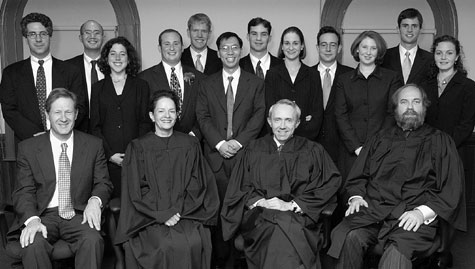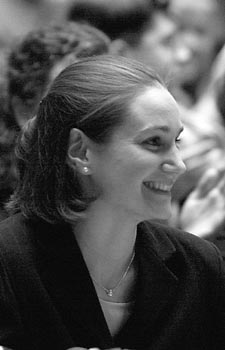Supreme Court Justice rules at HLS moot court

Imagine arguing a case before a U.S. Supreme Court Justice – and doing it in front of your parents, professors, and about 200 of your peers at Harvard Law School (HLS). Talk about butterflies in the pit of your stomach!
Four HLS students shared that memorable, albeit frightening, experience two weeks ago during the finals of the 89th annual Ames Moot Court Competition at the Ames Courtroom in Austin Hall.
Derek T. Ho HLS ’01 and Richard Squire HLS ’01 delivered oral arguments for the David A. Charny Memorial Team, which represented the petitioners, while Jessica Ellsworth HLS ’01 and Robin Wall HLS ’01 delivered oral arguments for the Myra Bradwell Memorial Team, which represented the respondents, in a fictitious court case pitting First Amendment rights against the right to privacy.

Justice David H. Souter AB ’61 LLB ’66, U.S. Supreme Court; Judge Frank H. Easterbrook, U.S. Court of Appeals for the 7th District; and Judge Judith W. Rogers AB ’61 LLB ’64, U.S. Court of Appeals for the District of Columbia Circuit, presided as judges.
“When I got up there I want to be able to say that all the lights faded away, the crowd faded away, and I was just having a conversation with a couple of people who are interested in the law. But that’s just not true,” Squires said. “It was absolutely nerve-wracking. I never forgot who it was or that the cameras were in front of me, but the nice thing is they are obviously interested in the law so if you’re into the law, you get a chance to actually get their thoughts on things. In that sense, it was very enjoyable.”
The petitioners attempted to sway the judges to strike down a mock statute regulating protest activity in the vicinity of a health care facility. In the specific case before the “court,” two protesters participating in a labor dispute were arrested for approaching people near a clinic, located in a public building, where abortions were performed.
Each of the oral advocates for both sides received 15 minutes to deliver their arguments before the court, during which time the justices peppered the would-be attorneys with questions about case history, precedence, and jurisprudence.
“We didn’t know which justices were going to take which positions,” Wall said. “We have an idea about the questions that are going to be asked. We were not surprised a great deal up there. We had planned almost everything out, but you never know the exact complexion of the question, the exact angle [the judge] will take, and what their real concerns are until they’re sitting up there in front of you on the bench.
“We could not have prepared enough,” he continued.
‘We had planned almost everything out, but you never know the exact complexion of the question, the exact angle [the judge] will take, and what their real concerns are until they’re sitting up there in front of you on the bench.’
Robin Wall HLS’01, Oralist
Indeed, both teams involved in the final round had been preparing for the evening for several months. The preliminary rounds of the competition were held last fall. The winners from those rounds advanced to the semi-finals in March and the two winning teams advanced to the final round on Nov. 16.
“It took us about four months of solid work spread out over a year and a half,” Wall said. “There were a lot of hours and a lot of late nights.”
According to Ellsworth, the past six weeks were especially grueling and the final two weeks were the most frenzied, with the team working three to four hours each day to prepare their arguments and refine their delivery skills. In the end, all the hard work paid dividends as both Wall and Ellsworth handled an array of judicial queries almost flawlessly at the podium and their team was named Best Overall in the competition.
“I think it went about as well as it could have gone, so I am very happy with that,” Ellsworth said. “And I’m very happy that it’s over.”
For Ellsworth, who was named Best Oral Advocate, the experience was a valuable one. “I think it’s very engaging,” she said. “It’s not quite as ‘real-life’ training as if you do clinicals where you actually work with clients, but in some ways it’s nicer because it allows you to intellectually engage and there isn’t really anyone who’s [fate is] hanging in the balance or who will be going to jail if you do something wrong.”
Ho, who called it “absolutely exhilarating” to argue his case before such “a very esteemed bench,” was awed by the complexity of the exercise. “The most intriguing part is the dynamic of the oral argument in the sense that you are having a conversation with judges who have all the power,” he said. “They have the power to ask whatever kinds of questions they want, and yet the tone is supposed to mimic a normal conversation. It’s interesting to see that tension play out in the courtroom.”
The courtroom experience provided each of the participants with a fresh perspective on what litigation is all about.
“The first and most obvious [lesson] is to know your case cold,” Ho said. “I think another lesson is that, at least when you are at this level, arguing before what was purported to be the Supreme Court, you need to have powerful reasons for the judges to decide the case one way or another. You need to give them a big principle to hang their hat on. I think that was clearly, in their view at least, the greatest failing on our side.”
Souter complimented both sides after the competition, noting their superior preparation and presentation skills. “This was a good match,” he said. “The people involved here who wrote the briefs and the advocates at the podium were credits to the Harvard Law School.”
“The ‘lawyers’ who you’ve seen today not only took the time, not only prepared this case to the gills but also displayed what I think is the most important quality of good oral advocates – and really the most difficult one – and that is the ability to engage in a conversation with the judges,” Easterbrook stated. “The judges are sitting up here in their black robes with the power to decide the case in the end, and it may be hard to conceive of engaging in a conversation with them, but that is what good advocacy is all about.”
Rogers also lauded both sides for their performance, while also encouraging them to “take advantage of the facts … that cry out for principles” when presenting their arguments before the high court.
The advice seemed to resonate in a room full of future attorneys, some of whom may one day argue a landmark case before the actual U.S. Supreme Court.




